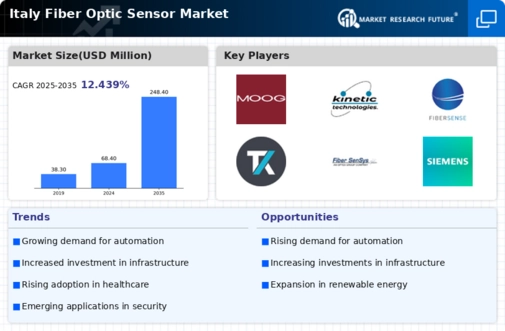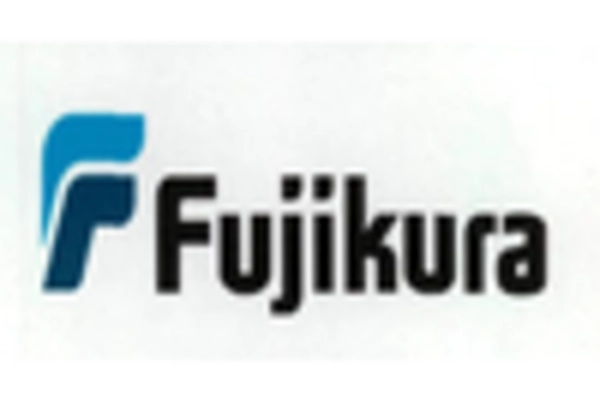Growth in Renewable Energy Sector
Italy's commitment to renewable energy sources is significantly impacting the fiber optic-sensor market. The integration of fiber optic sensors in renewable energy applications, such as wind and solar power, is becoming increasingly prevalent. These sensors are utilized for monitoring and optimizing energy production, ensuring efficient operation of renewable energy systems. The Italian government aims to achieve 55% of its energy from renewable sources by 2030, which is likely to drive the demand for advanced monitoring solutions. The fiber optic-sensor market is expected to benefit from this shift, as these sensors provide real-time data on energy output and system performance. Moreover, the ability of fiber optic sensors to withstand harsh environmental conditions makes them suitable for deployment in various renewable energy installations. This trend indicates a promising future for the fiber optic-sensor market as Italy transitions towards sustainable energy solutions.
Advancements in Industrial Automation
The fiber optic-sensor market is benefiting from the rapid advancements in industrial automation within Italy. As industries strive for increased efficiency and productivity, the integration of fiber optic sensors into automated systems is becoming more prevalent. These sensors provide precise measurements and real-time feedback, enabling manufacturers to optimize processes and reduce downtime. The Italian manufacturing sector, which contributes significantly to the national economy, is increasingly investing in automation technologies. Reports indicate that the automation market in Italy is expected to grow by 15% annually, which will likely drive the demand for fiber optic sensors. Furthermore, the ability of these sensors to operate in harsh industrial environments enhances their appeal, making them a preferred choice for automation applications. This trend suggests a robust growth trajectory for the fiber optic-sensor market as industries embrace automation.
Increased Focus on Safety and Security
The fiber optic sensor market is witnessing growth due to heightened concerns regarding safety and security across various sectors. Industries such as transportation, oil and gas, and manufacturing are increasingly adopting fiber optic sensors for monitoring critical infrastructure. These sensors offer real-time data on structural integrity, environmental conditions, and potential hazards, thereby enhancing safety measures. For instance, the Italian railway system is integrating fiber optic technology to monitor track conditions and detect anomalies, which is crucial for preventing accidents. The market for fiber optic sensors in safety applications is projected to grow by approximately 20% over the next five years. This trend underscores the importance of fiber optic sensors in ensuring operational safety and security, thereby driving their adoption across multiple industries in Italy.
Rising Demand for High-Speed Communication
The fiber optic sensor market is experiencing a surge in demand driven by the need for high-speed communication networks. As businesses and consumers increasingly rely on fast internet connectivity, the deployment of fiber optic sensors becomes essential. These sensors facilitate data transmission over long distances with minimal loss, making them ideal for telecommunications. The Italian government has recognized this trend, investing approximately €1 billion in expanding fiber optic infrastructure. This investment is expected to enhance connectivity in urban and rural areas alike, thereby propelling the growth of the fiber optic-sensor market. Furthermore, the increasing number of Internet of Things (IoT) devices necessitates robust communication systems, further driving the adoption of fiber optic technology. Consequently, the fiber optic-sensor market is poised for substantial growth as Italy continues to modernize its communication networks.
Regulatory Support for Infrastructure Development
Regulatory frameworks in Italy are increasingly supportive of infrastructure development, which is positively influencing the fiber optic-sensor market. The government has implemented policies aimed at enhancing digital infrastructure, including the deployment of fiber optic networks. Initiatives such as the National Plan for Recovery and Resilience (PNRR) allocate substantial funding for digital transformation projects, which include the installation of fiber optic sensors. This regulatory support is expected to catalyze investments in smart cities and advanced monitoring systems. The fiber optic-sensor market stands to gain from these developments, as sensors play a crucial role in managing urban infrastructure efficiently. With an estimated €40 billion earmarked for digital infrastructure improvements, the fiber optic-sensor market is likely to experience significant growth as Italy modernizes its urban environments.
















Leave a Comment